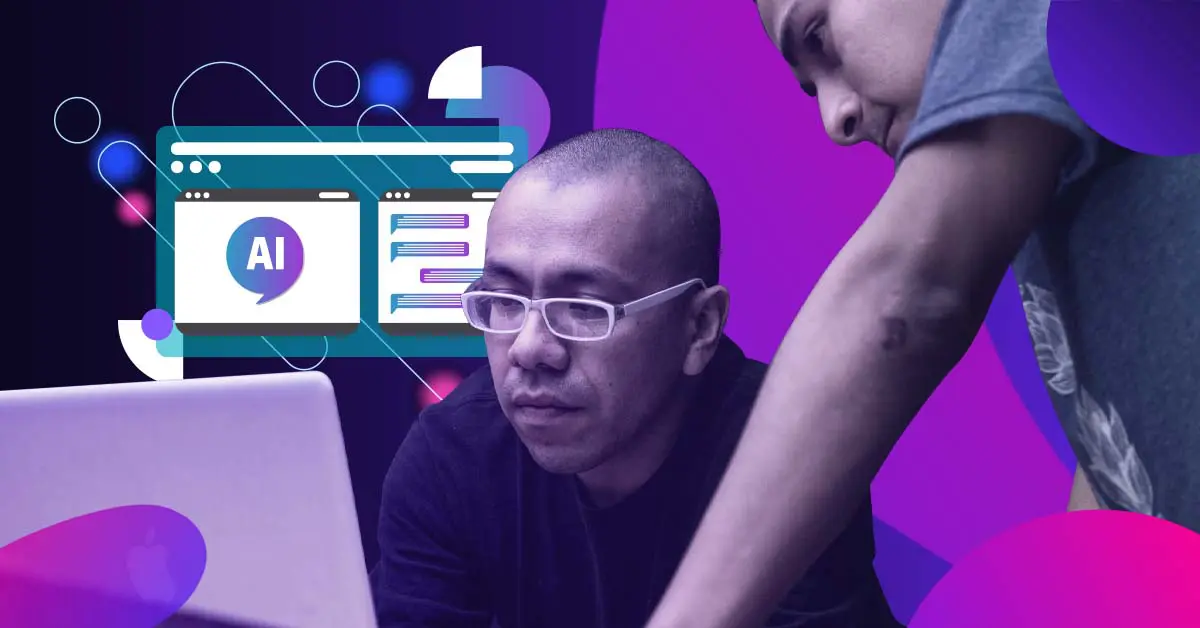
One of the hottest topics we see nowadays in the tech and business world involves AI and design thinking. It’s because design thinking offers a human-centric approach to doing business. And with the help of AI, entrepreneurs can understand challenges and devise solutions for them better and more efficiently. Because of this, many companies are fusing AI and design thinking to have a whole new process of operating and handling their businesses.
What is Design Thinking?

Design thinking is the process that lets people solve problems in different creative ways. It is concerned with the needs, desires, and experiences of humans. It can be used to solve any number of issues, from designing the perfect meal to developing the next million-dollar idea. Moreover, it uses creativity and empathy to create innovative solutions to real-world problems.
Designers use design thinking when they want to create products or services that people want and need in their lives. However, design thinking is not made solely for designers. It can be used by anyone who has a problem they want to solve or an idea they want to develop. Design thinking is an iterative process that involves multiple steps and a collaborative approach.
Design thinkers use a variety of methods, including brainstorming, prototyping, testing, and iteration, to create these products or services.
AI and design thinking are two of the most powerful tools at our disposal today, and it’s only natural that these two fields are increasingly becoming intertwined. The merging of the two can help designers make more informed decisions about what people need in their lives through data analysis.
What is AI?

AI stands for Artificial Intelligence. It is the branch of computer science that deals with intelligent behavior, such as learning, reasoning, and problem-solving.
AI is not just a buzzword. It has been applied in numerous industries, such as healthcare, transportation, and finance, . AI can improve the design process’s performance by providing suggestions for improvement or generating new ideas.
The phrase “Artificial Intelligence” was first used by John McCarthy at Dartmouth College in 1956.
The Difference Between AI and Design Thinking

Design thinking is an effective approach to solving problems in design and marketing. It is a process that can be applied to any situation and used to generate ideas. It is a customer-centered approach to innovation that focuses on the needs of people. Design thinking is a way to solve problems by using empathy, creativity, and collaboration.
AI, on the other hand, is a process for designing and building intelligent systems. AI can be used to solve problems in any field. Still, when combined with design thinking, it becomes more powerful because it gives designers the opportunity to explore new possibilities and find solutions that would not have been found otherwise.
The Relationship Between AI and Design Thinking

The concept of design thinking has been floating around for some time, but recent advances in artificial intelligence have made it possible to apply this concept in the design process.
Designers are using AI for many different purposes, which include generating design ideas, creating prototypes, and testing them before they are manufactured. Designers are also using AI for various purposes, like optimizing energy consumption or improving healthcare systems.
Moreover, designers can use AI as an additional tool for making decisions about what should be created and how it should be created. Designers can use AI to test different design concepts or simulate them with virtual reality technology before they are built. This is why combining AI and design thinking is trending right now.
AI and Design Thinking: the Future of Innovation

AI’s role in our lives is expanding and becoming more critical. Today, AI-based commodities, from self-driving cars to voice assistants like Siri or Alexa, abound. We can conclude that artificial intelligence has influenced every aspect of our lives, including our daily routine, healthcare, vehicles, and personalized recommendation systems.
However, the question of how to deploy AI efficiently in their processes remains. Because AI does not follow predictable norms and expectations, designing for AI necessitates different skills than designing for other types of technology. This is where the concept of design thinking emerges.
How AI and Design Thinking Affect Graphic Design

Artificial intelligence is indeed a disruptive force in the graphic design industry. That said, AI designers will surely struggle to replace their human counterparts completely. This is because they will still need humans for the commands they need to create designs.
An artificially intelligent designer would mean a paradigm shift for the entire niche. If we let machines generate designs instead of humans, the graphic design sphere will be forever altered. It could change by limiting the ability to create designs.
Creating “art and design” would become so easy. You will already have your design ready in just a few clicks and taps. But you might get generic designs or, worse, something unusable.
Since AI has been found to create realistic representations of almost anything, from people to buildings, some people believe that it will wipe out the careers of graphic designers. According to some, it will eliminate design studios and agencies. This couldn’t be farther from the truth, based on the images above.
AI: Not Entirely Disruptive

AI isn’t all bad. It lets designers create designs faster and more cheaply due to the increased speed and efficiency it provides. The power of AI will be at the rate with which it can analyze massive amounts of data and recommend design changes. Based on that data, a designer can then cherry-pick and approve changes.
As mentioned above, design thinking is about providing a good experience for consumers. And the ones in the best positions to keep humans in mind are the human designers, after all.
How to Use AI and Design Thinking for Your Business
Here are a few tips that can help you fuse AI and design thinking and put it to good use for your business:
Understand the Basics
Ensure everyone on your team understands the basics of AI and design thinking. This includes natural language processing, machine learning, and data analytics. To make this easier, use case studies in your industry where AI has added value. Cite their use in customer service, process automation, or data analysis.
Train your team in design thinking principles, emphasizing empathy, testing, ideation, and prototyping. Get them involved in the culture of solving problems creatively and valuing feedback.
Make a List of Your Business Challenges
Identify the challenges your business faces in its everyday operations. Gather data from every department to help you do this. Once you have the information, make a list of the most urgent to help you address the ones that are the priorities.

Find Solutions and Prototype
Schedule brainstorming sessions with design thinking in mind to generate a list of ideas on how to solve the problems you identified. Choose the most promising ones and develop prototypes for them.
Implementing AI
After getting a good working knowledge of AI technology, it’s time to implement its use. Select the appropriate AI tools that can help you target your identified challenges and work on the proposed solutions. Collect data for training and prepare to test various AI models.
Testing and Refinement
Gather user feedback and incorporate these by testing your chosen AI models and the solutions for your business challenges. You may want to test the design and AI model repeatedly to ensure it efficiently solves your challenges and problems. This will also be your chance for more refinements, if necessary.
Integrating AI and Design Thinking
Once the solution is refined, integrate them into your business workflow. Train your employees how to use the new system, if needed. Get them to become familiar with it and make it their norm. This will get them ready for new and more advanced technologies as they come.
Strive for Continuous Improvement
Once the AI model is integrated into your workflow, gather valuable feedback from your staff and customers. This will help you measure its success and develop strategies to improve it.
Measure Your Success
To know if your efforts at using AI and design thinking for your business are bearing fruits, always measure and monitor. Use KPIs (key performance indicators) to see if you’re heading in the right direction or if there’s something more you need to do. This way, you’ll find out how the implemented solution is doing and if it is serving its purpose.
You may also use analytics tools to gain valuable insights that can help you make data-driven decisions that will take you further into improving your business.

Encourage and Cultivate a Culture of Innovation
Lastly, to create a more customer-centered approach to your business while providing innovative solutions, you need to combine AI and design thinking. Make sure that your design and technical teams collaborate to foster a culture of innovation. You need to recognize and reward those who offer innovative and creative ideas for more successful growth of your business.
Leveraging AI and design thinking requires careful planning and thoughtful execution. While it may take up a considerable amount of your time and energy, it is worth your while. This powerful combination of AI and design thinking can enhance innovation, problem-solving, and overall competitiveness for your business. This beautiful marriage of modernization and empathy is the future. It’s crucial that you use it to advance your business and prepare it for what lies ahead.
AI and Design Thinking: The Answer to Everything?
While AI is an excellent tool for creating customer-centric designs, it can never replace the ongoing brand-building work that humans do. If we’re truly prioritizing a human approach to design, it makes far more sense to have real humans working on design projects.
With Penji, you get the best of both worlds. Our team of skilled human designers works directly with you to customize your designs. And we use AI to streamline the workflow process and get you set up with the perfect designer for your specific project. It’s the best of human creativity and AI advancement rolled into one service.
Isn’t it time you tried a graphic design service with unlimited potential?
About the author

Celeste Zosimo
Celeste is a former traditional animator and now an SEO content writer specializing in graphic design and marketing topics. When she's not writing or ranking her articles, she's being bossed around by her cat and two dogs.
Table of Contents
- What is Design Thinking?
- What is AI?
- The Difference Between AI and Design Thinking
- The Relationship Between AI and Design Thinking
- AI and Design Thinking: the Future of Innovation
- How AI and Design Thinking Affect Graphic Design
- AI: Not Entirely Disruptive
- How to Use AI and Design Thinking for Your Business
- Understand the Basics
- Make a List of Your Business Challenges
- Find Solutions and Prototype
- Implementing AI
- Testing and Refinement
- Integrating AI and Design Thinking
- Strive for Continuous Improvement
- Measure Your Success
- Encourage and Cultivate a Culture of Innovation
- AI and Design Thinking: The Answer to Everything?










